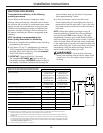
17
ge.com
During normal operation, the present time of
day and AM or PM and DAYS TO EMPTY show
in the control display area. When the demand
computer determines a recharge is needed,
RECHARGE TONIGHT begins to flash in the
display along with the present time. RECHARGE
TONIGHT flashes until the next recharge start
time, then changes to RECHARGE, which flashes
until the recharge is over.
Normal Operation, Control Displays
Sometimes, a manually started recharge may
be desired or needed. Two examples:
■ You have used more water than usual (house
guests, extra washing, etc.) and you may run
out of soft water before the next recharge.
■ The system ran out of salt.
Use one of the following features to start a
recharge immediately, or at the next preset
recharge start time.
RECHARGE TONIGHT
Touch (do not hold) the RECHARGE button.
RECHARGE TONIGHT flashes in the control
display area. A recharge will occur at the next
preset recharge start time. If you decide to cancel
this recharge, touch the same button once more.
RECHARGE
Press and hold the RECHARGE button until
RECHARGE starts to flash in the control display
area. The water softening system begins an
immediate recharge and, when over in about two
hours, you will have a new supply of soft water.
Once started, you cannot cancel this recharge.
Feature: Optional Recharge Controls
Feature: Memory
If electrical power to the water softening system
is interrupted, the control display is blank, and
the blue indicator light is off, but the control
keeps correct time for about 6 hours. When
power is restored, you have to reset the present
time only if the display and blue indicator light
are flashing. All other settings are maintained
and never require resetting unless a change is
desired.
If the time is flashing after a long power outage,
the water softening system continues to work as
it should to provide you with soft water. However,
recharge may occur at the wrong time of day
until you reset the control to the correct time
of day.
The control computer has a self-diagnostic
function for the electrical system (except input
power and water meter). The computer monitors
the electronic components and circuits for
correct operation. If a malfunction occurs,
an error code appears in the control display.
The chart on Error Codes shows the error
codes that could appear and possible reasons
for each code. See Manually Initiated Electronics
Diagnostics to further isolate the defect.
Feature/Service: Automatic Electronic Diagnostics


















